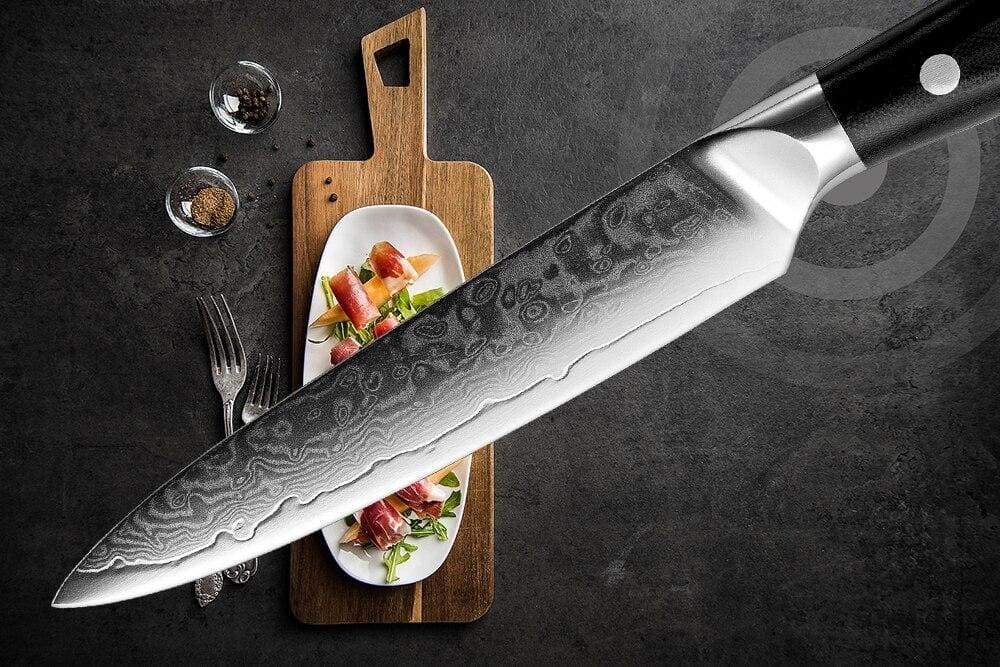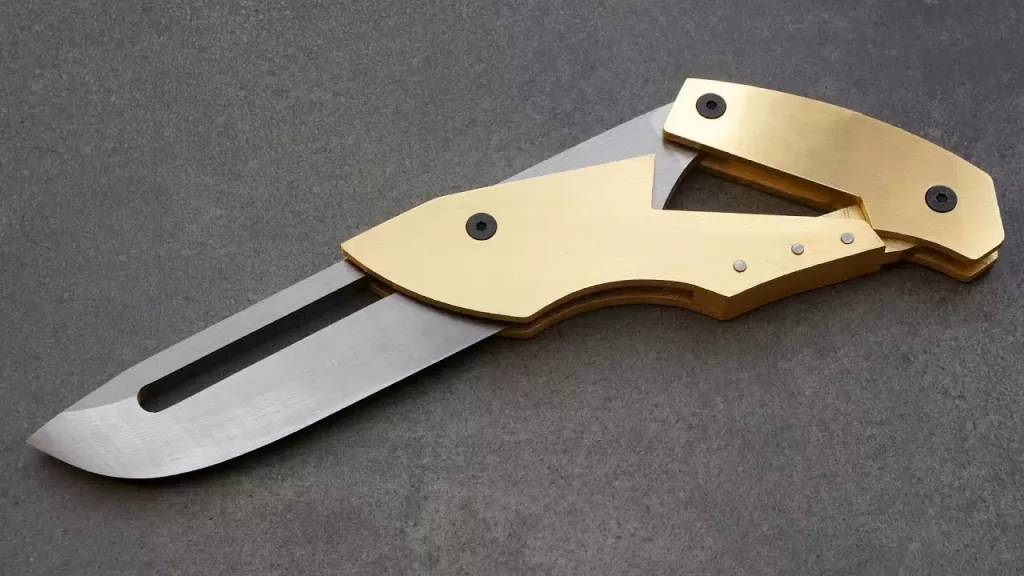Knife Features: Different Blade Textures

In this article, we’ll look at the various surfaces a knife can have. That standard surface, the most common texture for the flat of a blade. On more elaborate knives, however, there might be different textures. To improve their performance, knives also be dimpled, hammered, or use a textured steel like Damascus.
Smooth
The standard, smooth steel on the flat of the blade is easiest to produce for most manufactures. A natural product of the grinding process, it’s easiest to just machine polish a flat surface and make that the flat of the blade.To compensate for all that work, most good Damascus knives are quite expensive.
An issue with the perfectly smooth surface is that food sticks to it more readily, especially wet foods, which most foods will be. Everyone who’s cooked before knows how annoying it is to have to scraped bits of minces garlic or slices of tomato off the side of a knife. That is why the textured surfaces were developed and its implemented in the region.
Read More: learn more about them here.
Dimpled
These knives are often incorrectly labeled “hollow ground” knives. This is an inaccuracy since hollow ground actually refers to a shape of knife edge, not to the grinding of hollows into the blade.
Dimpled knives are becoming more and more common. These knives have little hollow dimples ground out of the blade, usually quite close to the edge. The idea behind these little pits is that they trap air inside, preventing food from sticking to the blade. The resulting cuts are smoother, easier, and it’s much easier to collect the food after cutting.
Hammered
An old-school version of the dimples, a hammered blade has been deliberately dented and textured during manufacture. The resulting uneven surface has a similar effect to the dimples, trapping air and preventing food from sticking to the flat of the blade. This feature is more commonly seen in Japanese-style knives, especially high-end traditional Japanese knives.
Damascus Steel
Damascus steel is a softer, layering of steel found in several styles of knife, though it’s most common among Japanese knives. As a softer steel, Damascus is typically used to clothe a harder, more brittle steel used for the core and edge of a knife. Since it is made up of several layers of folded steel, Damascus steel doesn’t typically have a smooth finish. Instead, it has a rough, textured surface that acts much like the dimpled or hammered steels above. Air is trapped in the tiny valleys of the steel, preventing food from sticking to the blade during cutting.
Textured Blade vs Flat Blades
Textured blades are best used for slicing and chopping tasks that aren’t producing very small pieces. Mincing and very fine chopping are better left to a flat blade. This is because tiny pieces of food can get lodges in the dimples or imperfections of the blade, and are even harder to get them out. The same bits may stick to a flat blade, but they’re easy enough to just swipe off.
Textured metals also need a little more attention when cleaning. Not only do bits of food get stuck in them, but they can be harder to spot when cleaning the knife. Water can also get trapped in the little reservoirs, increasing the chance of rusting or discoloration.
If you don’t know what those numbers and letters signify, then there is no way to know what quality of knife you are getting. Why do two seemingly identical knives such as the Fallkniven Idun hunting knife (one made of VG10 and the other of Damascus Steel) have a price difference of $900?
As you are searching the internet, perusing magazines, or shopping in stores for a hunting knife, you may become confused when reading about all the different types of metal that are used in the making of knife blades. You may very well know what stainless steel, titanium, carbon steel, and even Damascus steel are, but what about all those other types you read about?
Most people read names like 154 CM, 420, ATS34, AUS-8, CPM440V, etc., but can only shake their heads in bewilderment. If you don’t know what those numbers and letters signify, then there is no way to know what quality of knife you are getting. Why do two seemingly identical knives such as the Fallkniven Idun hunting knife (one made of VG10 and the other of Damascus Steel) have a price difference of $900?
Knife Blades
Knife blades are made of a combination of metals such as carbon, manganese, chromium, vanadium, nickel, molybdenum, and so forth. Depending on the composition of the metals used in the production of the knife blade, each knife has the potential to be more expensive to produce, be more resistant to rust, or hold a better edge than those made of cheaper materials. Following is a partial list of some of the more common types of steel used in the manufacture of knife blades.
Dimpled knives are becoming more and more common. These knives have little hollow dimples ground out of the blade, usually quite close to the edge. The idea behind these little pits is that they trap air inside, preventing food from sticking to the blade. The resulting cuts are smoother, easier, and it’s much easier to collect the food after cutting.
The standard, smooth steel on the flat of the blade is easiest to produce for most manufactures. A natural product of the grinding process, it’s easiest to just machine polish a flat surface and make that the flat of the blade.To compensate for all that work, most good Damascus knives are quite expensive.
Stainless steel
Stainless steel has a high chromium content to help it prevent rust. Contrary to public opinion, it is not rust proof. It is simply rust resistant, if not taken care of can succumb to rust. It is not a very strong metal, thus knife blades made of it tend to be somewhat cheaper than most.
AUS-8 is a high carbon, low chromium stainless steel. While not quite as rust resistant as stainless steel, it tends to be a stronger metal, thus making it a little more expensive than stainless. VG-10 is a high carbon steel with differing amounts of chromium, vanadium, molybdenum, and cobalt. It is especially popular with kitchen cutlery manufacturers as it will hold an edge and does not become brittle even after it has been sharpened many times as is common with many hard steels.
Damascus steel was used by the Muslims in the crusades. Its exact composition is unknown today, although many companies and smiths have experimented in trying to recreate it. It is an especially durable metal that tends to be very expensive.
What I like about the knife:
1. The tang of your fixed blade is just as important as the lock of your pocket knife. Your Koji will come with a full tang that extends all the way to the end of the handle. This feature is great because it makes the knife much stronger and less likely to break under pressure.
2. Each Koji comes with a 3 inch blade that is large enough to be an excellent cutting tool, but small enough to legally carry with you almost anywhere.
3. My knife came razor sharp right out of the box and has no problem holding its edge. The blade is double hollow ground out of ATS34 steel. The steel is great because it gives you a nice compromise between edge retention, toughness and flexibility.
4. Adding to the Koji’s impressive design is the attractive burl wood style handle. This handle not only looks great, but is durable enough to handle everyday use/
5. To complete this package, Buck gives you a glass-top wood display box that is perfect for the Koji. Although the knife is beautiful enough to keep in a display box I have no doubt that it also makes a great work knife.
What I didn’t like:
Everything about the Koji is high quality, but I would like to see the blade available with Damascus steel. The burl wood and Damascus would look fantastic together in my opinion.
Overall:
If you’re looking for a custom-quality knife that won’t break the bank, then check out Buck’s Koji knife. With a suggested retail value of $240, it might be one of the best bargains in the knife world today.
Dimpled knives
Dimpled knives are becoming more and more common. These knives have little hollow dimples ground out of the blade, usually quite close to the edge. The idea behind these little pits is that they trap air inside, preventing food from sticking to the blade. The resulting cuts are smoother, easier, and it’s much easier to collect the food after cutting.
If you don’t know what those numbers and letters signify, then there is no way to know what quality of knife you are getting. Why do two seemingly identical knives such as the Fallkniven Idun hunting knife (one made of VG10 and the other of Damascus Steel) have a price difference of $900?
These blades are superb at any slicing job, however, and it’s worth having one of them around just for making fine cuts other knives may not handle quite so well. If you do keep a slicing knife and a cutting knife, make sure to only hone the slicing knife with a ceramic or glass honing rod. A steel honing rod could change the qualities of the edge.You can buy online from ritzyknives.com
Kitchen Knives
If you’re looking for a custom-quality knife that won’t break the bank, then check out Ritzknives. With a suggested retail value of $240, it might be one of the best bargains in the knife world today.
Stainless steel has a high chromium content to help it prevent rust. Contrary to public opinion, it is not rust proof. It is simply rust resistant, if not taken care of can succumb to rust. It is not a very strong metal, thus knife blades made of it tend to be somewhat cheaper than most.
Conclusion
If you’re looking for a custom-quality knife that won’t break the bank, then check out Buck’s Koji knife. With a suggested retail value of $240, it might be one of the best bargains in the knife world today.
Stainless steel has a high chromium content to help it prevent rust. Contrary to public opinion, it is not rust proof. It is simply rust resistant, if not taken care of can succumb to rust. It is not a very strong metal, thus knife blades made of it tend to be somewhat cheaper than most.
Conclusion
If you’re looking for a custom-quality knife that won’t break the bank, then check out Buck’s Koji knife. With a suggested retail value of $240, it might be one of the best bargains in the knife world today.
Stainless steel has a high chromium content to help it prevent rust. Contrary to public opinion, it is not rust proof. It is simply rust resistant, if not taken care of can succumb to rust. It is not a very strong metal, thus knife blades made of it tend to be somewhat cheaper than most.
Conclusion
If you’re looking for a custom-quality knife that won’t break the bank, then check out Buck’s Koji knife. With a suggested retail value of $240, it might be one of the best bargains in the knife world today.
Stainless steel has a high chromium content to help it prevent rust. Contrary to public opinion, it is not rust proof. It is simply rust resistant, if not taken care of can succumb to rust. It is not a very strong metal, thus knife blades made of it tend to be somewhat cheaper than most.



